 Democratic People’s Republic of Korea (Late 1970s/Early 1980s-Present)
Democratic People’s Republic of Korea (Late 1970s/Early 1980s-Present)
Amphibious Light Tank – Unknown Number Built (500 Sometimes Mentioned)
North Korea maintains one of the most peculiar large scale military industries of the modern world. Though the most famous of the country’s vehicles are without a doubt the main battle tanks – the Chonma-ho and Songun-Ho – North Korea actually manufactures a very wide range of vehicles, from self-propelled artillery pieces to light armored personnel carriers. An interesting vehicle in North Korea’s arsenal, and one which may have played a pivotal role in the development of North Korea’s military industry, is the M1981 Shin’heung, an amphibious light tank also known as the M1985 (its name given by the US Department of Defence) or the PT-85 (a popular name given due to the vehicle’s often greatly exaggerated link to the PT-76).
The sources of North Korea’s military and tank industry
The Democratic People’s Republic of Korea (DPRK), often just known as North Korea, was formed following the capitulation of Japan. The Soviet Union came to control the northern half of Korea. The state was solidified after the 1950-1953 Korean War led to a stalemate, with both pro-American South Korea and pro-Soviet North remaining in place.
The North Koreans quickly began to develop a form of arms industry. As early as 1949, they began the manufacture of the Type 49 submachine gun, a copy of the Soviet PPSh-41. Their production of firearms continued through the 1950s and 1960s, to include the Type 58, an AK copy, as well as some of the first “indigenous” weapons, or at least some of the first to differ from the Soviet arsenal. Introduced in 1964, the Type 64 pistol was a close copy of the old Belgian FN 1900, an odd choice for a new pistol. It was most likely inspired by the pistol’s symbolic role as a common pistol in 1900-1940s Asia, which was employed by Korean partisans against Japanese rule.

The production of armored vehicles appears to have started in the 1970s. This coincides with North Korea raising military expenses after those had been kept at a moderate level throughout the late 1950s and 1960s, as well as the country being forced to assert its independence from the Soviet Union due to the Sino-Soviet Split complicating North Korea’s relations with the two larger communist powers on its borders.
Up to this point, North Korea had merely used vehicles supplied by the Soviet Union or China, but this option started to appear fairly unreliable as it was questionable whether the Soviets or Chinese would provide modern weaponry, seeing as North Korea was trying to keep balanced relations between the two communist powers that were now bitter rivals.
The Korean People’s Army adopted a locally-produced version of China’s Type 63/YW531 in the early 1970s, the vehicle appearing to be designated as “323” in North Korea (though it is often called VTT-323 by western enthusiasts), and being given the name of M1973 (after the year it was first observed) by the American Department of Defence. It already incorporated some significant differences from the original vehicle, such as an additional road wheel, as well as a turret armed with twin KPV 14.5 mm machine-guns.
It also appears that, at least to an extent, two large orders of tanks from the Soviet Union were produced and assembled in North Korea – an order for 1,000 T-54s, passed in 1966 and delivered from 1967 to 1974, and another order for 1,000 T-55s, passed in 1970 and delivered from 1972 to 1982.
It also appears that a local production run of the PT-76B, or more likely simply the final assembly of vehicles otherwise produced in the Soviet Union, took place in the 1970s. The place of this PT-76 production run was most likely the Ryu Kyong-su Tank Factory, in Sinhung county – the latter name Sinhung or Shin’heung often being associated to the vehicles which would be produced in this factory (typically amphibious vehicles such as the 323 and obviously the M1981).
The Shin’heung appears
The M1981 Shin’heung amphibious tank appears to have been developed in this context, and it took inspiration from a variety of vehicles North Korea had previously acquired or even produced locally – the 323 and PT-76, but also perhaps the T-54/T-55 and the Type 63 amphibious tank.

As is typically the case for North Korea, the vehicle’s development is completely unknown in the West, and the vehicle’s existence was known for the first time when lines of Shin’heung paraded down Kim-Il-Sung square in Pyongyang – this being on the parade for the 40th anniversary of the Fatherland Liberation War, in 1985, leading to the vehicle first being designated as M1985 by the American Department of Defence. The vehicle is theorized to have actually originated in the late 1970s or the early 1980s, with the North Korean designation seemingly being “M1981 Shin’heung”.
Observing the vehicle, though, can lead to some amount of guessing as to how the vehicle was developed, or rather, which vehicles it took inspiration from. The Shin’heung is often thought, in popular imagination, to be a mere copy of the Soviet PT-76, merely refitted with an 85 mm gun. This is not helped by the popularity of the “PT-85” name for the vehicle. In practice though, North Korea’s design is quite different from the Soviet one. Its hull is based on the one of the 323, though largely modified, and while the turret clearly takes inspiration from the Soviet tanks, it is clearly not the same design either.
Hull Design: From APC to amphibious tank
The hull of the M1981 Shin’heung is based on the 323, which, from the 1970s onward, has been produced in large numbers by North Korea, appearing to be the country’s standard armored personnel carrier.

Major modifications had to be undertaken to turn this fairly diminutive armored personnel carrier hull into an amphibious tank. The most notable was the vehicle is considerably lengthened. The original YW531 was 5.48 m long, but while accurate measurements of the M1981 are not known in the West, the vehicle is clearly longer than the 323. Another road wheel was added, bringing the total to 6, and an estimation places the vehicle at a length of about 7.60 m based on the various available photos. The vehicle also appears to have been widened to an extent, notably over the fenders, and incorporates sloped sides – it appears the width went up from 2.98 m on the 323 to around 3.10 m on the M1981.
The hull appears to have been lowered to an extent – a quite logical course of action, seeing as the troop compartment was removed. The rear of the hull was considerably changed to accommodate the change of purpose. The rear doors for the infantry were removed, and a hydrojet, of a design similar to the PT-76’s, was added on each side. The radiator of the engine appears to be installed at the rear as well, with the exhaust on the roof of the rear hull.

The exact engine which is used on the M1981 Shin’heung is unknown. The original Chinese YW531 is known to use an 8-cylinder, 320 hp air-cooled and turbocharged diesel engine, the KHD BF8L 413F, and it is possible this engine may have been retained on the M1981. A 6-cylinder water-cooled diesel producing 240 hp is sometimes mentioned as an alternative. As for the suspension, the vehicle appears to have torsion bars similar to those found on the 323. The M1981 lacks the fenders covering the upper part of the suspension and tracks. The tracks are similar to those found on the 323 and PT-76. The hull appears to be home to one crewman, the driver, seated at the front right of the hull. He has a number of episcopes at his disposal in order to view the outside of the vehicle, as well as an openable hatch.
The vehicle, with the turret included, is estimated to weigh in at around 20 tons, and a maximum speed of around 60 km/h is sometimes mentioned – which would make it similar to China’s Type 63 amphibious tank, and about 15 km/h faster than the PT-76. The speed on water is estimated to be around 10km/h – the same as the PT-76, with which the M1981 likely shares the hydrojet design. A range of about 500 km has also been estimated.

The armor values of the M1981’s hull are unknown but are likely similar to vehicles such as the PT-76, 323, or Type 63. This would give it armor somewhere between 10 and 20 mm in thickness, likely able to only resist rifle-caliber projectiles and artillery shrapnel, as is typically expected of a light amphibious tank.
A number of tools are stored on the sides of the hull. When first shown in 1985, the M1981 featured four headlights, two on each side, installed towards the front, though new light configurations have appeared since then. Spare track links are often seen on the sides of the vehicle as well.
Turret design and armament: Multiple inspirations
The M1981 features a horseshoe-shaped turret. Though it may seem vaguely similar to the PT-76’s in general shape, it appears to be higher, with the armor plates sloped inward at a lower angle than on the Soviet vehicle. Most details are also quite different. The turret features a notable bulge on the rear-right of the turret to accommodate the commander’s cupola, which includes a number of episcopes. Instead of a large, single hatch, the M1981 features two, one on the rear right (in the commander’s cupola) and one on the rear left. Rounded in shape, those hatches are fairly similar to those found on the T-54, which North Korea may have produced in the late 1960s and 1970s. The turret has a flat section at the front, where the main gun is installed, alongside a coaxial machine-gun to the right and a vision port to the left. Circular hand grips can be found on the sides of the turret. Including the turret, the M1981 appears to be about 2.80 m high.

The main armament of the M1981 is an 85 mm gun. It is very likely based on the Chinese Type 62-85TC rifled gun, present on the Type 62 and Type 63 light tanks, which North Korea is known to have used from the 1970s onward. The guns generally look similar, though there are some differences. The bore evacuator is further back on the North Korean model, which may be caused by the gun being longer altogether.
The ammunition used by the Chinese gun, and thus likely North Korea’s version as well, is the 85×629 mmR, the same caliber as the WW2-era Soviet 85 mm used in later models of the T-34 as well as the SU-85. China is known to produce a variety of ammunition for the gun, comprising AP, APHE, HE, Frag-HE, HEAT, APFSDS-T and smoke rounds. It is quite likely North Korea has access to some, if not all of these rounds, and produces some locally, seeing as the same shells can also be fired from the country’s T-34-85 fleet. The quantity of ammunition the vehicle may carry is unknown. The coaxial machine gun used is of an unknown model, though the PKT is a potential candidate.
As for the crew, the M1981 appears to house two crewmen in the turret, a commander and a gunner. It has, however, sometimes been mentioned that the vehicle could house a third turret crewman, a loader. While all photos of the vehicle in parades only show two crewmen standing out of the turret, the seemingly larger size of the M1981’s turret in comparison to the PT-76 may perhaps be able to house an additional loader.
When first shown in 1985, the M1981 featured an additional weapon: a Malyutka missile launcher, either the Soviet 9M14 or the North-Korean produced model, the Susong-Po. This missile was mounted on top of the turret, behind the main gun. It has, however, only been observed on the M1981 once, during the 1985 parade. Since then, no photos of the vehicle show it armed with a Malyutka. Though it is possible the missile may be fitted back onto the vehicle if need be, it has been theorized that giving the M1981 a missile for the 1985 parade was done with the goal of spreading misinformation on the vehicle’s actual capabilities, without the M1981 actually being adapted to fire the Malyutka. It is sometimes claimed the vehicle may be fitted with a 14.5 mm KPV heavy machine-gun on an anti-aircraft mount. Though this would not be an unusual feature on a North Korean vehicle, it has never been observed on the M1981.
Service of the M1981
The M1981 Shin’heung has been operational in the Korean People’s Army (KPA) since the early 1980s. The vehicle is generally understood to have fulfilled an important role in the offensive-minded KPA of the pre-1990s: South Korea is a country comprising a large number of rivers, which considerably complicate operations for heavier, non-amphibious tanks, such as the various models of Chonma-Ho. The M1981 would not be as troubled by these rivers and could operate alongside amphibious armored personnel carriers such as the 323 to provide them with additional firepower that is a lot easier to move around wet areas than heavier vehicles.
The M1981 has also, quite recently, been shown in amphibious landing exercises, in which the vehicles featured a foldable plate (known as a trim vane) used to break waves, which is not typically seen during parades. The role of landing vehicle is another one which can reasonably be expected of a light amphibious tank, the M1981 playing, in general, a role similar to the PT-76 in the Red Army or the Type 63 amphibious tank in the People’s Liberation Army.



Upgrades and modifications
Ever since it was first seen in 1985, the M1981 has become a fairly common vehicle in North Korean parades. This allows observers to see several upgrades and modifications which have been applied to the North Korean vehicle since the 1980s.

A first upgrade was conducted at an unknown time, but likely in the 1990s or even perhaps late 1980s, seeing as the majority of photos of M1981s we know of, including a number of black-and-white or poor quality photos, show them with elements that were added with this unknown upgrade. This upgrade includes a large infrared projector placed on the right of the main gun and is linked to it by braces for elevation. New lights are also found on the hull, two to three, depending on the vehicle, on the right side of the main front plate, and, not always mounted, an additional one on the smaller front-left side plate. These lights are of various configurations. In some parades, for example, the M1981 appears to feature two infrared lights along with a regular one.



In a 2015 parade, the M1981 appeared with several new upgrades, in addition to the ones seen in 2010. The vehicles were given six smoke grenade launchers, three on each side of the turret, as well a new secondary weapon: a 9K38 Igla man-portable anti-aircraft missile, likely a model of North Korean manufacture. As with the Malyutka back in 1985, whether or not this weapon is truly intended to be deployed with the M1981 remains to be seen. If so, it would grant the vehicle some self-defense capacities against helicopters and low-flying aircraft. With a crewman likely having to operate the weapon from the vehicle’s exterior, its practicality is quite dubious. This practice is very common in North Korean parades though, with all kinds of military vehicles – from the most modern models of the Chonma-ho tanks, as well as the new Songun-Ho, all the way to lightly armored self-propelled artillery pieces – all having been shown with Iglas.

Production
The production numbers of the M1981 – as with any military vehicle from North Korea – are impossible to know in detail, due to the highly secretive nature of the country.
It should be noted that the M1981 appears to, in any case, have continued being regularly used and even developed upon long after its introduction in the early 1980s. Indeed, as late as 2009, a new vehicle based on its hull, the M2009 “Chunma-D” armored personnel carrier, was observed. This would tend to indicate that the vehicle was still in production (though it has also been theorized the Chunma-D may have begun production as a way to repurpose the M1981 production lines after production of the type was ended), as new variants using its hull were being introduced. Therefore, it is quite likely an important number of M1981 Shin’heungs are still present in the Korean People’s Army. An estimate of 500 vehicles in service is often brought up but is pretty much unverifiable.

The M1981 likely played a key role in the development of North Korea’s arms industry. It is by no means the first armored vehicle produced in North Korea, with the 323 and most likely T-54 and T-55, and perhaps even the earliest models of the Chonma preceding it. However, unlike all of those vehicles, the M1981 is not merely an exact copy or slightly modified version of the original model. Though it very obviously takes some inspiration from other vehicles of the era, most notably the 323 and PT-76, but also perhaps the T-54 and Type 63, it is not a mere variant of any of those, and massively differs from any of them individually. As such, the M1981 could be argued to be North Korea’s first truly indigenous armored vehicle, setting a major precedent for a North Korean military industry. The industry would only grow in the following decades, developing, notably, updates of the Chonma-Ho, which, from a mere lightened copy of the T-62, would be vastly upgraded, eventually evolving into the current Songun-Ho. This later tank, while still in the vague filiation of the T-62, has little that remains from the Soviet 1960s main battle tank.

Conclusion – A small, obsolete light tank for the world, a massive step forward for North Korea
The M1981 Shin’heung is, by today’s standards and even to an extent in the 1980s, an obsolete vehicle. The capacities of its main gun, as well as its fire controls, are certainly obsolete against any kind of modern competition – China, which operated light tanks with similar armament in the form of the Type 62 and Type 63, has long updated them with 105 mm main guns and more up-to-date fire control systems, and has now introduced more modern vehicles which have replaced the first and are on their way to replacing the second. For North Korea though, no replacement appears to exist for the M1981, with even the October 2020 parade not featuring any. The vehicle has received some upgrades in the last few years, but they are vastly insufficient, and while it may very well still be in production, the Shin’heung is long past its prime.
Nonetheless, the vehicles likely played a major role in North Korea’s industrial history, allowing the country to switch from a mere license/local producer of Chinese or Soviet equipment, as several of the Eastern Bloc countries were, to a country which develops, at least to an extent, its own vehicles. This development turned out to be crucial for the country known as the “Hermit Kingdom”: the collapse of the Eastern Bloc left North Korea isolated, with only some moderate links remaining to Russia, and military links seemingly restricted to mostly China, Syria, and Iran. Its ability to develop its own vehicles has likely been crucial in allowing the Korean People’s Army to field vehicles more advanced than mere T-62 copies. However, even the most modern North Korean tanks, such as the Songun-Ho or the new tank revealed in 2020, would not compare favorably at all to modern South Korean tanks such as the K2, K1A2 or K1A1.


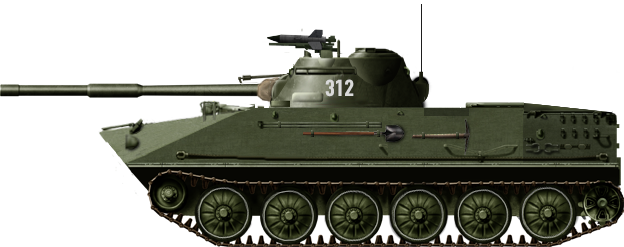
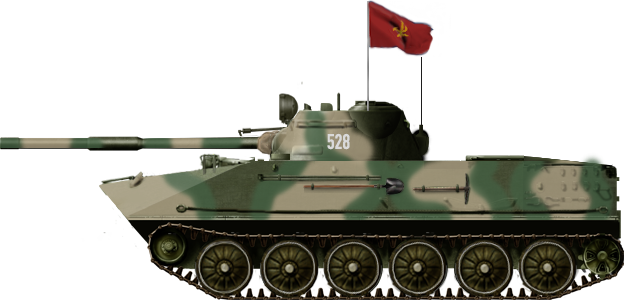
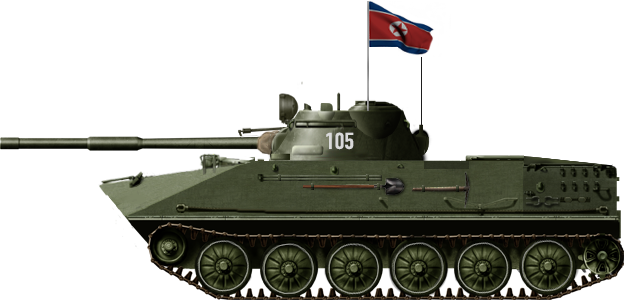
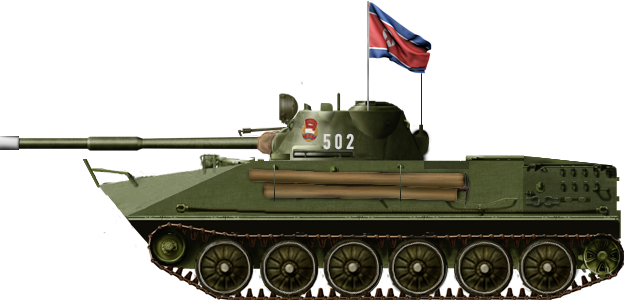
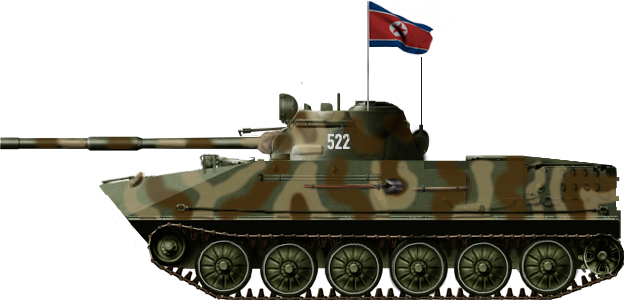
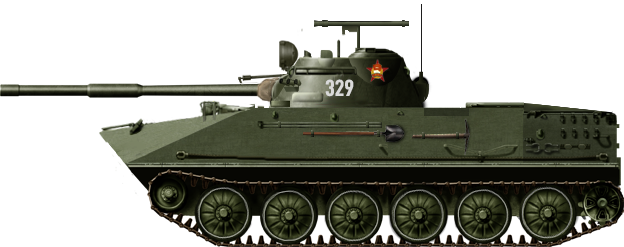
Illustrations by Pavel “Carpaticus” Alexe based on work by Tank Encyclopedia’s own David Bocquelet
M1981 Shin’heung specifications (estimations) |
|
| Dimensions (L-W-H) | 7.60×2.10×2.80 m (estimations) |
| Total Weight, Battle Ready | ~20 tonnes |
| Engine | Unknown (Perhaps a 320 hp 8-cylinders air-cooled diesel engine or a 6-cylinders water-cooled 240 hp diesel engine) |
| Suspension | Torsion bars |
| Maximum speed (road) | ~60 km/h |
| Maximum speed (water) | ~10 km/h |
| Range | ~500 km |
| Crew | 3 (driver, commander, gunner), 4 sometimes claimed |
| Main gun | 85 mm derived from Type 62-85CT |
| Secondary armament | Coaxial 7.62 mm machine-gun Either 1 Malyutka ATGM, 1 Igla MANPAD, or perhaps 1 KPV 14.5 mm machine-gun (whether any of those would actually be used in operations is unknown) |
| Armor | Most likely 10 to 25 mm |
| Total Production | Unknow, about 500 sometimes mentionned |
Sources:
THE ARMED FORCES OF NORTH KOREA, On The Path Of Songun, Stijn Mitzer, Joost Oliemans
Military today
https://massimotessitori.altervista.org/armoursite/nkindigenoustanks/pt-85/pt-85.html
Small arms review
Oryx Blog – North Korean vehicles

One reply on “M1981 Shin’heung”
I have an idea. Can you make a mod for video game Total Tank Simulator with all tank on Tanks Encyclopedia???